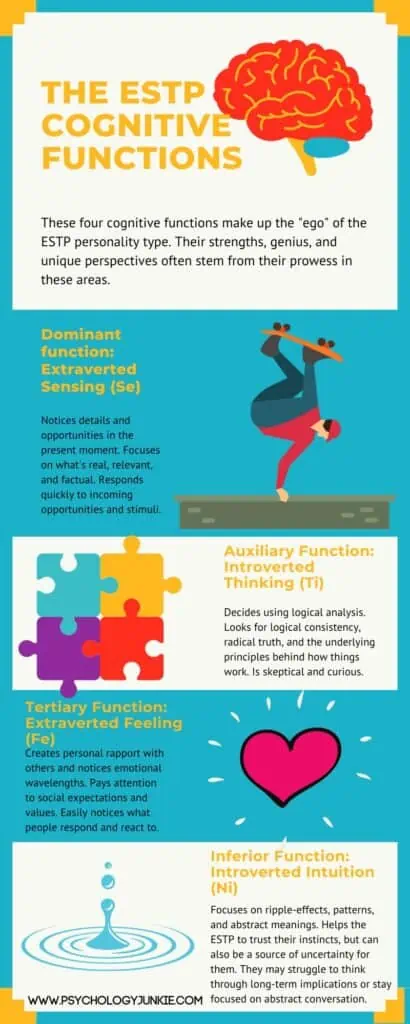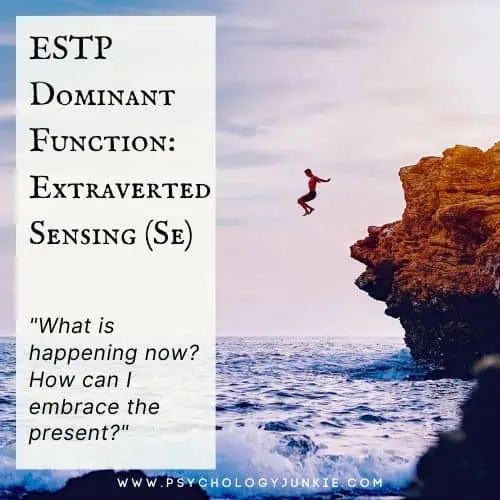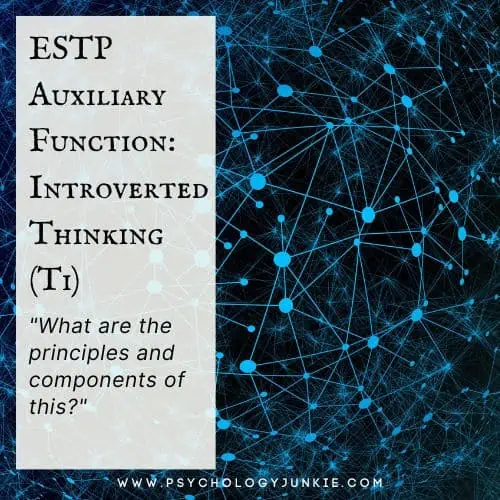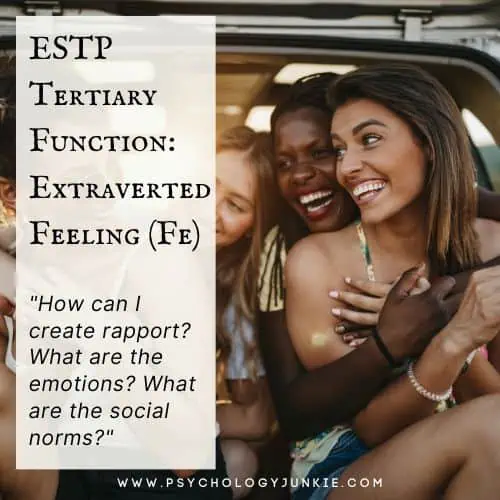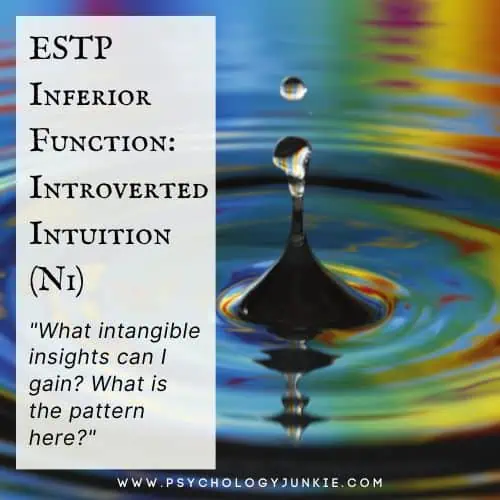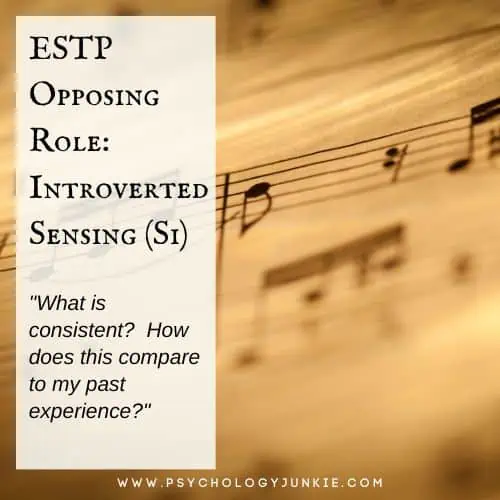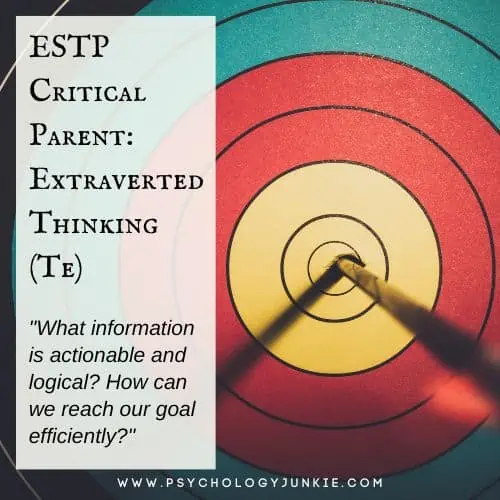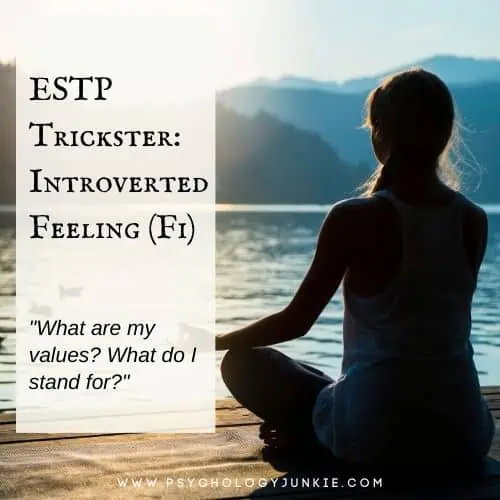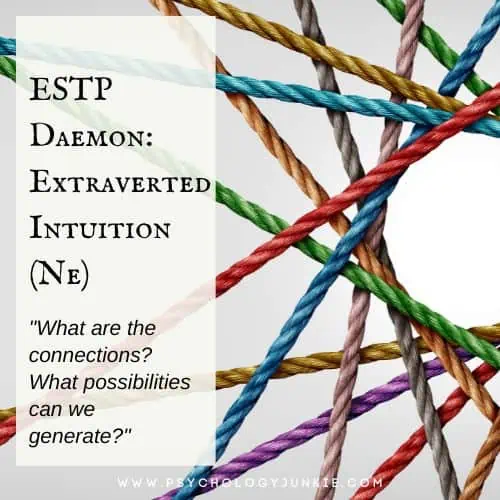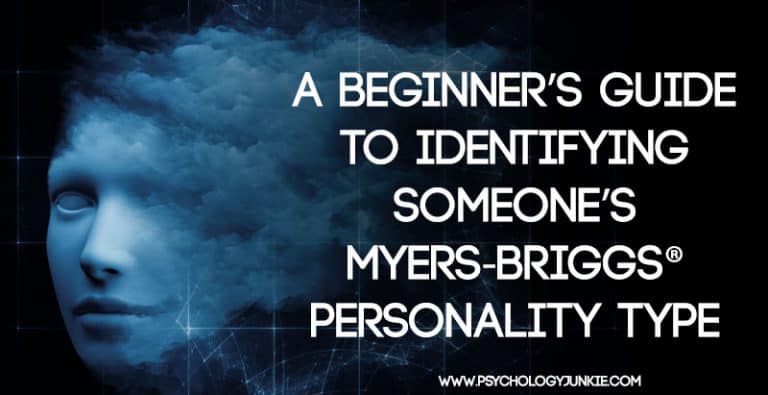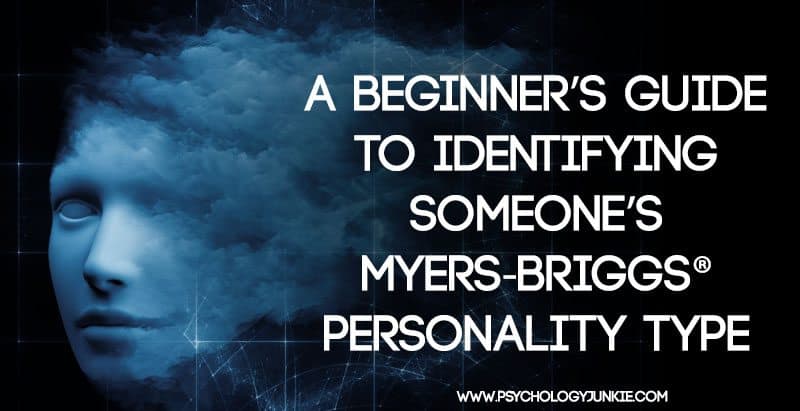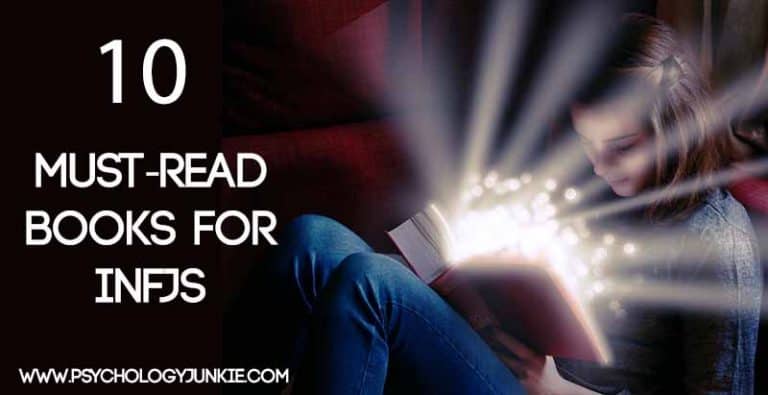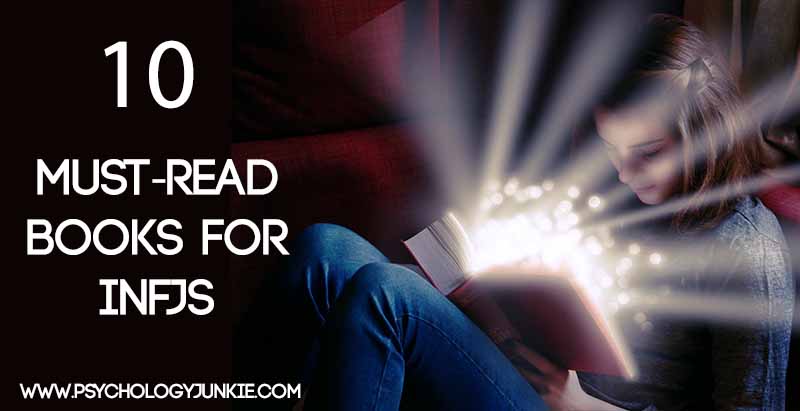Your ESTP Cognitive Function Guide
In today’s article, we’re taking a look at the cognitive functions of the ESTP personality type. ESTPs are one of the 16 Myers-Briggs personality types. They are known for their love of action, attention to detail, and clever wit. Let’s jump into understanding the cognitive functions and how they show up for ESTPs!
First Off, What Are Cognitive Functions?

If you’re scratching your head about what “cognitive function” even means, this is where you’ll want to begin (please don’t skip ahead!)
Cognitive functions serve as the building blocks of a person’s personality type. They consist of eight functions that are grouped into two categories: Introverted functions (Introverted Thinking, Introverted Intuition, Introverted Feeling, Introverted Sensing) and Extraverted functions (Extraverted Thinking, Extraverted Sensing, Extraverted Feeling, Extraverted Intuition).
Introverted functions are more internalized and less expressive on the outside. They aren’t as reactive in real-time but are deeply felt, thought, or observed either way.
Extraverted functions are ones that you use when you interact with the outer world. They are more responsive in real-time and are often more visible on the surface.
The cognitive functions can also be grouped into Perceiving functions (Introverted Intuition, Extraverted Intuition, Introverted Sensing, Extraverted Sensing) and Judging functions (Introverted Feeling, Extraverted Feeling, Introverted Thinking, Extraverted Thinking).
Perceiving functions (Intuition or Sensing) take in information and observations while Judging functions (Thinking or Feeling) help us narrow down options in order to make decisions.
Each of the 16 Myers-Briggs® personality types has a unique combination of four primary functions and four shadow functions that determine how they process information, make decisions, and interact with the world.
ESTP Cognitive Functions
Let’s start by taking a look at the four primary functions of the ESTP personality type. If you’re an ESTP you’ll naturally resonate most with your top four functions.
Dominant Function: Extraverted Sensing (Se)
The dominant function for ESTPs is Extraverted Sensing. This function gives them the propensity to be highly observant and tuned into their immediate surroundings. They notice all the sights, sounds, colors, scents, and movements happening around them and can feel perplexed when others aren’t as aware as conscious of these details as they are.
Extraverted Sensing in the dominant position also tends to make ESTP’s action-oriented. They are quick to respond and adapt to changes in their environment and enjoy new and novel situations where they can take in new sensory information. They enjoy engaging in activities that provide sensory or physical immersion, be they sports, art, cooking, hiking, or even dancing! Every ESTP is different and they all have different tastes, but they all enjoy engaging and responding to their environment in a physical, tactile way.
Extraverted sensing also prioritizes facts, details, and observable reality over speculation or “hunches”. Because of this, ESTPs are highly realistic and trust things that they know through lived experience. They are often grounded and down-to-earth and avoid pretentiousness or “head-in-the clouds” theorizing that lacks a foundation in the facts of life.
Auxiliary Function: Introverted Thinking (Ti)
ESTPs have an auxiliary function called Introverted Thinking, which helps them analyze and categorize information. They are skilled at identifying logic in situations and breaking down problems into smaller parts. Thanks to their analytical mind, they can make logical and informed decisions that aren’t swayed by a flurry of ever-changing emotions. For ESTPs, knowing how an object, system, or process is pieced together is important and they can often spend a great deal of time deciphering the inner workings of a piece of technology, an automobile, or even a household appliance. I once knew an ESTP who took apart his family’s toaster AND microwave when he was a child, just so he could see how they worked.
Because ESTPs pair Introverted Thinking with Extraverted Sensing, they often apply their logic to actual tangible reality. They may learn all the in’s and out’s of crafting a pool table, planting orange trees, or they may delve into anatomy & physiology so they can make new discoveries in a particular medical field. While NTPs (INTPs and ENTPs) tend to apply their logic to theories, beliefs, and ideas, ESTPs will more often apply their logic to things they can see, touch, feel, and experience with their five senses.
Introverted thinking is concerned with the “how” of things and can get very wrapped up in the nitty-gritty details of how ideas, processes, or objects are composed. Because of this, ESTPs often know the mechanics of things better than anyone else. They can be very precise and nit-picky when it comes to the details, often going off on tangents to explain how something works in great detail!
Tertiary Function: Extraverted Feeling (Fe)
The tertiary function for ESTPs is Extraverted Feeling. This function helps them connect and relate to others. They can pick up on the emotions and needs of people around them, allowing them to be charismatic and adapt their communication style accordingly. While ESTPs are indeed Thinking types, their tertiary Extraverted Feeling can make them a little more charming and socially aware than some other Thinking types. Rubbing shoulders with others, making perfectly-timed jokes, and instigating banter and humor into a social situation is something that is helped by their feeling process.
However, Extraverted Feeling is less developed for ESTPs than their Se and Ti functions, so they might struggle with being consistently emotionally attentive or understanding more complex emotional dynamics. At times, they can be reactive or too caught up in the mood of others and trying to make an impression.
Introverted Intuition (Ni)
The inferior function for ESTPs is Introverted Intuition, or “Ni” for short. Introverted Intuition focuses on ripple effects, patterns, and abstract meanings and concepts. It asks, “What else is going on here?” “What’s the implication of this event?” or “What deeper meaning lies beyond the surface?”
As the least developed of the ESTP’s primary functions, their Intuition has fluctuating strength and certainty and is less relied upon than the other three functions. However, it can manifest as trusting their instincts or getting gut feelings about the future. These insights can be vague, and when under stress, ESTPs may rely too much on these instincts, potentially leading to impulsive decisions.
As ESTPs age and mature they become more drawn to the inferior function. It’s not uncommon to find elderly ESTPs with a newfound interest in philosophy, spirituality, or abstract ideas they would have never shown interest in when younger!
The ESTP’s Shadow Functions
In addition to these main functions, ESTPs have for shadow or unconscious functions:
- Introverted Sensing (Si)
- Extraverted Thinking (Te)
- Introverted Feeling (Fi)
- Extraverted Intuition (Ne)
These shadow functions act as potential points of growth but may also appear as blind spots or weaknesses. For most people, the shadow functions act as projections made about other people or blind spots that we don’t see in ourselves or associate as part of ourselves. We see them as “other” and often fail to take responsibility when they fail us. Shadow functions can play a role in personal development, as ESTPs can work on integrating these unconscious functions to create a more balanced personality.
The Opposing Role: Introverted Sensing (Si)
ESTPs have Si in place as their opposing role. ESTPs are often be caught up in the current moment, and may not see the value in taking time to reflect on past experiences and lessons learned. When they’re encouraged to dwell on past details or use a “tried-and-true” method rather than improvising, they can feel like the person doing the encouraging is being oppositional. They prefer to learn through trial-and-error and spontaneous improvisation than following a guideline someone before them created. At the same time, they can oppose others by pointing out details that don’t add up and reminding others of the past or a guideline to follow.
The opposing role function can cause people to make projections or unfair judgments of others. ESTPs may see types who value Introverted Sensing (SJ personality types) as nitpicky, argumentative, oppositional, and time-wasting. This is due to the fact that Introverted Sensing has an “oppositional” feel to it for ESTPs, especially when they’re young and less mature. They may see expressions of Introverted Sensing as pointless and getting in the way of their Se need for action and immersion.
With time and maturity, ESTPs can learn to accept Introverted Sensing and respect it in their own lives. They can learn to trust this process to give them good backup information about the past and how it is relevant to the present or future.
The Critical Parent: Extraverted Thinking (Te)
ESTPs have Extraverted Thinking as their critical parent. This function focuses on creating structures and outlines so that goals can be achieved in a timely manner. Rather than getting into the nitty-gritty of how something works, Te focuses primarily on how information can be used. It looks at metrics, pass/fail, and if/then logic in order to make objective decisions.
Because Extraverted Thinking is in the critical parent role for ESTPs, it can manifest in them being highly critical of others when a deadline shows up or they’re being forced into an Extraverted Thinking space. When ESTPs are fault-finding, they may use Extraverted Thinking language to tear someone down; suddenly becoming hyper-aware of timelines, structures, rules, guidelines, and metrics.
Because ESTPs have Extraverted Thinking in the critical parent role, they can see expressions of Extraverted Thinking (found in TJ personality types) as inherently critical. TJ types use Extraverted Thinking as a method to help or lead in most cases, but ESTPs may find them “bossy” or “fault-finding” simply because they’re projecting their own critical parent onto the TJ. Relationships and friendships with TJ personality types might be a little strained until the ESTP can understand that TJs are not coming at them with a harsh, minimizing, critical intention when they express their thoughts.
With time and maturity, ESTPs can learn to accept and benefit from Extraverted Thinking. At times, albeit unpredictably, they can create order out of chaos and create regulations and systems that improve efficiency for individuals or teams.
The Trickster: Introverted Feeling (Fi)
ESTPs have Introverted Feeling as their trickster. This can manifest in them analyzing people’s motives and values in order to find fault and get them stuck in lose-lose situations. Unhealthy ESTPs may use their Fi to manipulate others or they may come across as insincere when trying to build relationships. When ESTPs are feeling overwhelmed, they can turn to “trickster” tactics–like lying or misleading people about their intentions–in order to achieve the desired outcome.
ESTPs can also see expressions of Introverted Feeling (found in FP personality types) as inherently untrustworthy and manipulative. This is due to projecting their own trickster energy onto the Feeling-Perceiving type.
With time and maturity, ESTPs can develop Introverted Feeling and see its value and place in their lives. They can learn to decipher their deeper beliefs, feelings, and the choices that will give them a greater sense of meaning.
The Daemon: Extraverted Intuition (Ne)
ESTPs have Extraverted Intuition as their daemon. Because of that, they tend to devalue random hypothesizing or speculating. Their focus is on concrete realities and specific details rather than imagining hypothetical situations or abstract relationships. They prioritize the present world over the future possibilities. To the down-to-earth sensor, hypothesizing and predicting is too risky because life is constantly changing. The saying “Don’t worry about tomorrow, today has enough trouble of its own” will likely appeal to ESTPs.
When ESTPs are under the energy of Extraverted Intuition, they may increase their sensitivity to negative situations and create multiple negative scenarios in their mind and get carried away with destructive thoughts. In some cases this can lead them to believe in conspiracy theories or other harmful ideas. Despite typically being grounded, during highly stressful times, they may be more prone to losing sight of reality.
Similarly, ESTPs may see expressions of Extraverted Intuition (found in NP personality types) as chaotic or irresponsible. Because they have Ne as their daemon type, they might project this energy onto others when an NP type expresses their intuition. While NPs are generally creative and imaginative thinkers who are open to possibilities, ESTPs may perceive them as being too airy or overly optimistic about the future.
You can find out more about the ESTP’s shadow functions here: The Shadow Functions of the ESTP Personality Type
Why Cognitive Functions Matter:
Overall, it’s important for ESTP personality types to understand the role of their cognitive functions in order to better navigate interpersonal relationships and understand themselves. Having a grasp of the different ways peoples’ minds work can help us to have more empathy, patience, and clarity when dealing with one another. It also encourages a healthier self-awareness and understanding, which is essential for ESTPs in order to maintain their sense of identity and cultivate positive relationships.
The cognitive functions provide a framework to understand our own strengths and weaknesses within our personalities as well as those around us. Ultimately, this knowledge will help ESTPs (and everyone!) become more aware of themselves and the effects they have on others; leading to healthier relationships both personally and professionally.
What Are Your Thoughts?
Did you enjoy this article? Do you have any thoughts or ideas to share? Let us and other readers know in the comments!
Discover more about your personality type in our eBooks, Discovering You: Unlocking the Power of Personality Type, The INFJ – Understanding the Mystic, The INTJ – Understanding the Strategist, and The INFP – Understanding the Dreamer. You can also connect with me via Facebook, Instagram, or Twitter!
References:
Depth Typology: The Guide Map to Becoming Who We Are by Mark Hunziker (Write Way Publishing Company LLC, 2016)
Understanding Yourself and Others™ An Introduction to the Personality Type Code by Linda V. Berens and Dari Nardi (InterStrength, 2004)
Other Articles You Might Enjoy:
10 Things You Should Never Say to an ESTP
10 Reasons Why ESTPs Make Amazing Friends
Subscribe to Our Newsletter

Want to discover more about personality type? Get the inside scoop with Susan Storm on all things typological, along with special subscriber freebies, and discounts on new eBooks and courses! Join our newsletter today!


